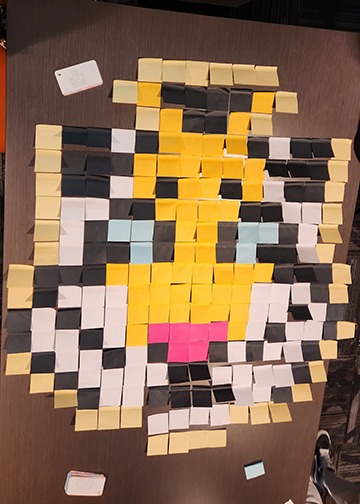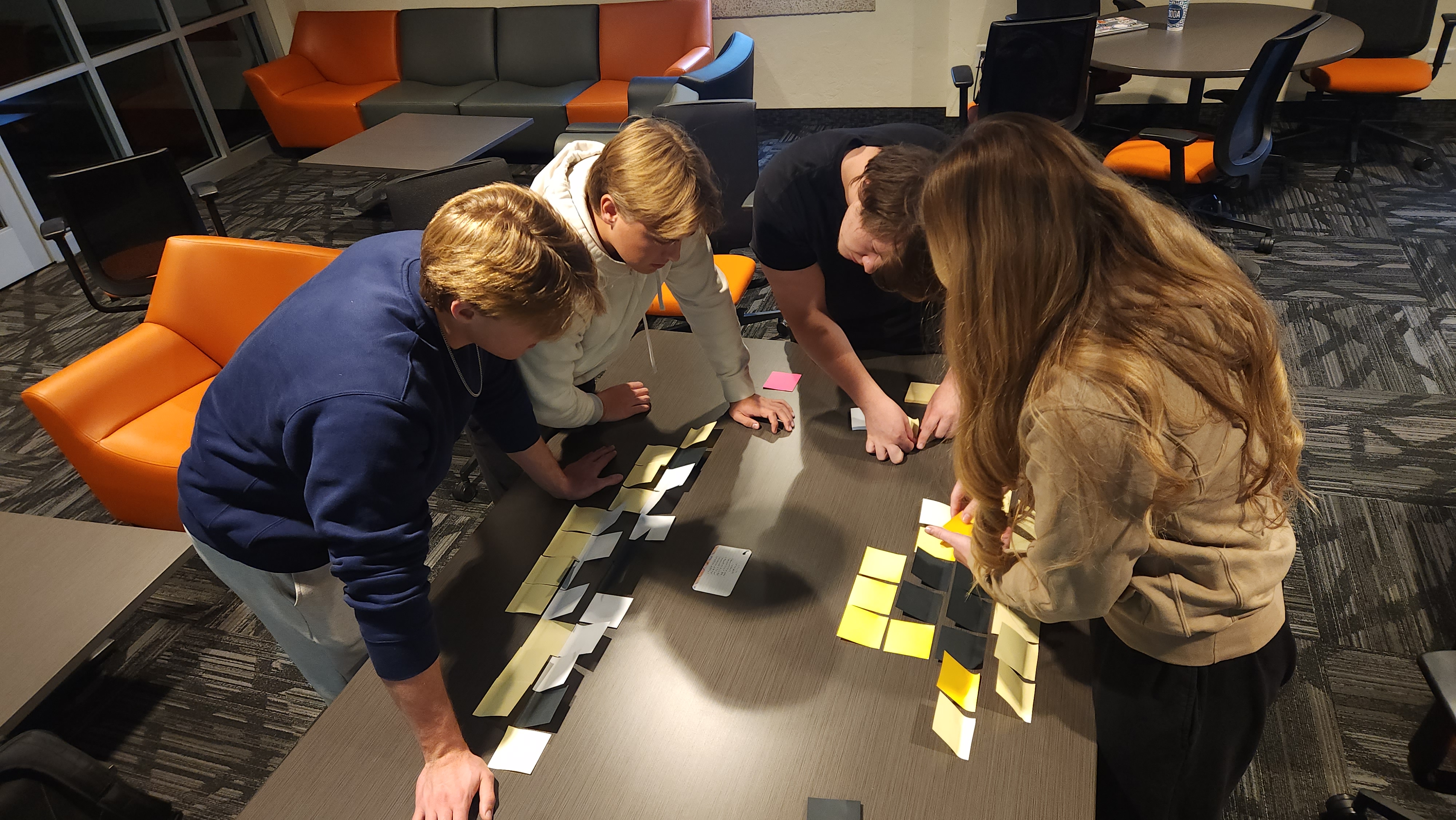Have you ever been thrown into a project that you did not want to do? Well that was not the case with this sticky activity. In the Creative Process Honors class, we did just that. Having to collaborate with a group of people you do not know very well can be frightening but when you go about it in a fun way, you create companions. During this process, a mixture of brainstorming and problem solving showed itself and created a fun experience. Creativity is a key aspect of any goal and to succeed you have to listen to the ideas of those around you.
Instructions:
The instructions were clear. Our whole class was split into groups of around five students and brought into the College of Business building. We were each given sets of orange, black, white, pink and blue sticky notes. The goal of the activity was to create the image of a tiger that was made out of sticky notes. However, the tricky part was the fact that the tiger that we had to copy was in another room.
To make it more interesting and difficult, only one person could go into the other room, from each team, at a time. It was then that that person could relay the information back to their team. Another limitation was that we had only twenty minutes to complete the assignment and be the winner out of the three teams.
It was then that our team knew we had to win.
Creative Process:
This project required a blend of creativity, teamwork, and problem-solving, with each group developing a unique strategy to accurately recreate the original sticky-note tiger. Their different methods showcased inventive approaches to observing, recording, and reassembling visual details, revealing a variety of creative processes and strategies.
The first group approached the task incrementally, focusing on precision and gradual progression. They decided to send one group member at a time to examine specific portions of the tiger, ensuring careful attention to detail with each visit. After observing a section, the group member would return and relay the small, intricate details of that portion, allowing the group to piece together each fragment meticulously. This process continued, one segment at a time, until the tiger image was fully assembled, embodying the group’s commitment to accuracy through a step-by-step accumulation of details.
The second group adopted a highly organized documentation approach, emphasizing thoroughness and systematic recording. This group sent a single member with a notebook into the observation room, tasking them with meticulously noting each colored sticky note in its respective position on the tiger. This recorder took note of the arrangement, color patterns, and layout, enabling the group to reconstruct the image as closely as possible to the original design. The group’s reliance on a single, detailed reference document illustrated their strategy for precision and allowed for a consistent, unified recreation of the tiger.
The third group took a more dynamic and collaborative approach, combining observation with immediate action. They sent one group member to record details of the top half of the tiger, bringing this information back to the rest of the team. While the group started recreating the initial half, the recorder returned to capture the details of the lower half, ensuring they could continue without delay. This method allowed them to work on the tiger in two phases, prioritizing efficiency and teamwork in their process.
Each group's strategy highlighted a unique way to approach the challenge, whether through incremental observation, systematic documentation, or a combination of real-time teamwork and phased observation. Together, these approaches underscored the diversity of creative processes and emphasized the role of collaboration, ingenuity, and strategy in effective problem-solving.
Key Takeaway:
Creativity is not just a concept; it’s a collection of diverse expressions and experiences that inspire us to invent new ways of sharing our ideas, thoughts, and feelings. During this collaborative activity, the combination of teamwork and varied perspectives served as a powerful catalyst for fostering a passionate, creative environment. By recreating an image of a tiger—an activity that may seem simple at first glance—we found that expressing creativity becomes easier in a supportive environment where criticism is used as a tool for growth rather than to demean others.
One specific instance arose when the tiger image did not fit on the table we were using. Rather than bickering among the team, we worked through the issue by delegating tasks and focusing on finishing the project within the given timeframe. When individuals can trust one another and focus on solutions, obstacles become opportunities for growth.
Furthermore, when discussing the topic of criticism, it is important to distinguish between candor and honesty. Honesty typically carries the weight of social expectations, while candor involves open expression without any expectation—whether social, economic, or otherwise. This distinction ties back to the essence of creativity: recognizing the value of diverse backgrounds and appreciating the different perceptions that arise when ideas are viewed through multiple lenses. Ultimately, the creative process leads us toward greater understanding and brings people together to create something that could never be accomplished alone.
Conclusion:
Being placed in a sticky situation can be seen as a frightening experience. However, that was not the case this week in the Creative Honors Seminar: The Creative Process. Working together on a project that creates a finished product is a very satisfying experience. Using sticky notes to create a silly picture was a joyous exercise and allowed us to have fun, while also learning about the creative process. One of the reasons why our group did so well was because we delegated tasks and no one was sitting around, being a viewer to the experience. Everyone was doing tasks and having fun while doing it. By embracing each other’s ideas and adapting to unexpected obstacles, we learned that creative collaboration flourishes in an environment of trust and open expression. The most important thing to remember, in a project like this one, is that scale exists.


